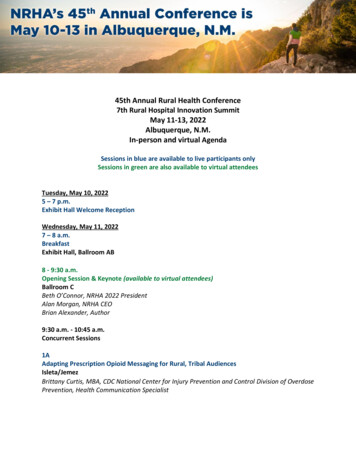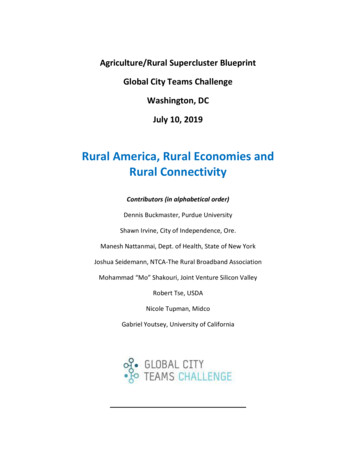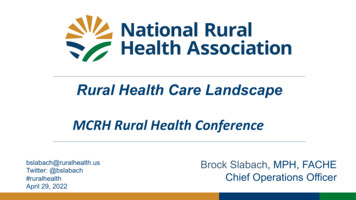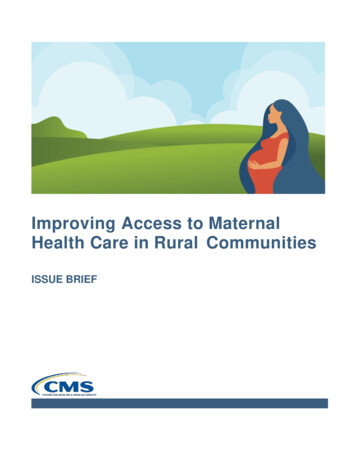
Transcription
Direct GuideDirect Project OverviewThe Direct Project is a set of standards, protocols and services that enable simple, secureelectronic transport of health information (push messaging) between healthcare participants(e.g. providers, labs). The Direct Project will facilitate “direct” communication with a focustowards more advanced levels of interoperability than simple paper can provide. Directfocuses on transportation security mechanism for the content being exchanged, but doesnot specify the actual content itself.Any two participants, organizations or communities without a central governance structurecan implement the Direct Project standards and services. The Direct Project will coexistwith other HIE services based on the existing Nationwide Health Information Networkstandards and services.ApplicationsThe Direct Project applications are similar to commonly available email applications, butprovide encrypted messaging to ensure the safety and security of exchanged information.Just like email, the Direct Project requires the user to know the recipient’s address. MostDirect Project applications do not include a system for searching and finding patient recordsor provider contacts (direct project addresses). Benefits of deploying a Direct Projectapplication include nationwide communication, securely encrypted messages andattachments, cost-effective information exchange, and relatively simple implementation.Minimum RequirementsThe following are minimum requirements to participate in Direct exchange:1) Known and trusted “Direct addresses” for the sender and the recipient: a Directaddress is an identifier of the provider and location. This address is essentially anemail address.2) A digital certificate which associates (binds) the Direct address to a public key (oftenreferred to as a “public certificate”) and to a private key.Sending a Direct message to another participant, the sender will require the recipient’sDirect address and the recipient’s public certificate; the receiver will receive the Directmessage through his/her direct address and will decrypt with their private key. Otherminimum requirements (encryption, trust verification, and other privacy and securitymechanisms) can be provided by Health Information Service Providers (HISPs) or productvendors.Vendor SolutionsMany EHR vendors offer information exchange modules to support exchange of informationamongst providers with the same EHR solution. A limited number of vendors offer solutionsfor exchange between multiple EHR vendors. Exchange between EHR solutions ranges from1National Rural Health Resource Center218-727-9390rhitnd@ruralcenter.org
natively available Direct Project applications (built directly into EHR solutions by the vendor)to complete interoperability resulting from vendor-to-vendor interfaces.Benefits of deploying an EHR solution from your vendor include functionality built directlyinto the EHR, minimal disruption to clinical workflows and low use of internal technicalresources. A list of vendors that are committed to implementing Direct are listed ipationThe Direct Project is an open government initiative. The decision to participate in the DirectProject depends on the value the organization will receive, willingness to comply with theprotocols, and comfort with security and privacy protections.The organization can obtain an organizational certificate from the community trust anchor,configuring the anchor in their implementation, and associating their new certificate withtheir organization. Trust anchors are configured by each organization implementing Directspecifications to ensure common trust among exchange participants. The anchor decidesthe criteria by which certificates may be issued for the purpose of message exchange withina given community. Direct software does not issue certificates, it merely allowsadministrators to associate certificates with endpoints and domains- so the certificates areissued by trust anchors. If two communities share a common definition for certificate andidentity assurance they can either use the same trust anchor OR import each other’s trustanchors, therefore sharing more information with each other. Certificates can be issued atthe community or national level.Diagram 1: Direct Project sending to XDR with Trusted Service Provider2National Rural Health Resource Center218-727-9390rhitnd@ruralcenter.org
In this diagram, the sender and receiver have ensured that agents of the sender andreceiver (for example, HIO, HISP, intermediary) are authorized to act as such and areauthorized to handle protected health information according to law and policy. TheReceiver has supplied the Sender with an address and digital certificate that route themessage to the "Direct Project to XDR" Destination HISP. Therefore, the Receiver isexplicitly indicating their trust of this Gateway. The "Direct Project to XDR" DestinationHISP is considered a trusted service provider. Any Direct Project sender can send to anyXDR endpoint as long as there is a Trusted "Direct Project to XDR" Destination HISP serviceavailable to do the translation. The XDR receivers have one way to receive directedmessages regardless of whether the messages originate from inside their XDR network (e.g.Exchange) or from outside that network using the Direct Project.There is no need for the XDR receivers to have independent digital certificates, although theTrusted Service could manage multiple individual digital certificates (even though there islittle additional benefit, since all of them terminate in the one service).Diagram 2: Direct Project and Exchange(Please note that "NHIN Direct" has been renamed to "The Direct Project", and "NHINExchange", to "Nationwide Health Information Network Exchange.")Source: The Direct Projecthttp://wiki.directproject.org/Intersection with Exchange3National Rural Health Resource Center218-727-9390rhitnd@ruralcenter.org
In this diagram:a) HISP A sends to NwHIN Gateway Bb) NwHIN Gateway A sends to HISP BRegardless of the model, the transformation of three things is required:Transport - use of particular transport protocol (SOAP/REST/SMTP). These are fairlyclear transformations and are considered relatively easy to implement Trust - transformation of trust models. Complexity is not yet clear as trust model forDirect has not been completely identified Metadata - needs detailed comparison and discussion to be able to see how far apartthe two models are.Note that both the Direct Project and NwHIN Exchange are content neutral so notransformation is necessary, although there may be issues in content exchange becausesome NwHIN Exchange partners may want to restrict the types of content they will accept. Meaningful UseDirect-enabled products can be used by providers and organizations to transport and sharedifferent types of content specified by Meaningful Use – thus the combination of MeaningfulUse specified content and Direct project specified transport standards may satisfy certainStage 1 Meaningful Use requirements that involve health information exchange (e.g. caresummary, exchange and lab results delivery). Stage 2 Meaningful Use requirements thatdebuted in August 2012 included requirements on secure health transport specificationsincluding XDR and XDM for Direct MessagingBeing “Direct-enabled” means that the user can support the common specifications for theDirect Project and can send/receive information to and from using Direct specifications. Theuser must follow the Direct Project Implementation guidance. There is no independentcertification process for establishing that an application or network is “Direct enabled” and isnot currently part of Meaningful Use certification or EHR certification.The Direct Project will be the required transport for summary of care documents,specifically, the Applicability Statement for Secure Health Transport. There are optionaltransport standards as well. There are two choices for the use of optional standards:1) Option 1: Certification can be performed for both the Applicability Statement forSecure Health Transport specification and the specification utilizing the XDR and XDMprofile for Direct Messaging.2) Option 2: Certify for both Simple Object Access Protocol (SOAP)-Based SecureTransport Requirements Traceability Matrix (RTM) version 1.0 standard and the XDRand XDM for Direct Messaging.For the optional standards, the SOAP-Based Secure Transport Requirements TraceabilityMatrix (RTM) specification was selected instead of the more specific IHE profiles. SOAP is aprotocol specification for exchanging structured information in the implementation of WebServices in computer networks. It relies on Extensible Markup Language (XML) for itsmessage format, and usually relies on other Application Layer protocols, most notablyHypertext Transfer Protocol (HTTP), for message negotiation and transmission.The Direct Project specifications provide entry-level transport in a point-to-point fashion,while the SOAP-based IHE profiles provide for more advanced communications where4National Rural Health Resource Center218-727-9390rhitnd@ruralcenter.org
healthcare facilities can query one another for patient information.Meaningful Use Stage 2 compliance testing may begin by July 1, 2014. Then, on to Stage 3criteria, which will be implemented in 2016 at the earliest.Scope, Interoperability and DeploymentScope LimitsThe Direct project does not embody a model of “pulling information”. Direct's focus is moreon the transport of health information but it is not the complete “interoperability” package.InteroperabilityIn order for effective interoperability with Direct the following must be determined:1) How are messages sent and received (e.g. Direct Project specified transport)2) Structure and format of the exchanged content3) Items to use within their content (SNOMED Clinical Terminology)Direct did not define specifications for content because the MU Final Rule and otherstandards groups have made strong recommendations for information to be exchanged andhow it’s coded. Direct will be used to transmit unstructured messages (text, PDF) andhighly structured messages (including HL7 v2 messages, Continuity of Carerecords/documents).Direct does not ensure semantic interoperability, but it helps to support data exchange bysupporting one important foundational element of exchange- a common layer for transport.The content transported using Direct-mediated exchange is based upon shared standardsfor message structure and terminology; Direct can support semantic interoperability bybeing the conduit for information flow.DeploymentThere are three deployment models for Direct:1) An entity sends and receives Direct messages through a web portal offered as aservice of a HISP. This is much like a web-based email account.2) An entity sends and receives Direct messages using a standard email client, whichhas been Direct-enabled. e.g., through a software plug-in or an upgrade to the emailclient.3) An entity uses an electronic health record system software that is Direct-compliant,through which it sends and receives Direct messages from within the application.The process of generating data from a EHR and sending a Direct message and/orreceiving and integrating the contents of a Direct message into your electronic healthrecord, is completely dependent on the capabilities of the application provided by thesoftware vendor.Privacy and SecurityThe Direct -mediated exchange is required to conform to applicable federal and state laws.Direct is utilized within the pre-existing framework of trust among exchanging entitieswhere patient identity is known and where consent and legal authorization allow theinformation to be transferred. Direct may not address all the additional requirements atthe state level.5National Rural Health Resource Center218-727-9390rhitnd@ruralcenter.org
Direct assumes that both the sender and the receiver have the appropriate authority andconsent to share the messages in question. There are no particular components embeddedin Direct methodologies for ensuring that these rights and permissions have beenestablished. In other words, privacy assurance is outside the bounds of transport layer asdefined in Direct. The privacy assurance is the responsibility of the sender and the receiver.Security is managed in the transport layer of Direct through the use of digital certificatesissued by Certificate Authorities to encrypt messages as they travel from sender to receiver.The digital certificate model, ensures that only the intended recipient of a message canunlock and decrypt that message. Direct does not provide security for the message onceit’s opened by the recipient. The receiver’s Direct-compliant interface (Direct compliantEHR, email program or web portal) must provide assurance that they unencrypted messageis sufficiently secure as they would for any other sensitive patient data.Protocols, Specifications and StandardsThe Direct project uses Simple Mail Transport Protocol (SMTP) for email transmission.SMTP is an Internet standard for electronic mail (e-mail) transmission across InternetProtocol (IP) networks.However, the Direct project is neutral about the content of data transmitted using itsprotocol. The only requirement is for the use of Internet Engineering Task Force (IETF)standards. For other Direct transactions, another set of standards are the Integrating theHealthcare Enterprise (IHE) based standards.MIME (Multipurpose Internet Mail Extensions) is an Internet standard that extends email tosupport content beyond simple ASCII plain text data. Content is packaged using MIME andoptionally, XDM. XDM (Cross-Enterprise Document Media) is an interchange integrationprofile, a specification for the exchange of electronic health record documents on portablemedia. XDM provides for zipped file transfer over e-mail, which is very relevant to theDirect Project specifications.Confidentiality and integrity of the content is handled through S/MIME encryption andsignatures. S/MIME (Secure/Multipurpose Internet Mail Extensions) is an Internet standardfor securing MIME data.The Direct S/MIME provides privacy and data security through encryption andauthentication, integrity assurance and no-repudiation of email origin through singing.Authenticity of the Sender and Receiver is established with X.509 digital certificates, whichare typically obtained through the HISP. Direct relies on the use of embedded subject andissuing chain. X.509 standards for a PKI-based infrastructure will push Direct users tocreate trust policies that speak in terms of certificates, public key infrastructure andcertificate authorities.Specifically, the HISP to HISP backbone uses the XDR standard, a lightweight point-to-pointprotocol designed specifically to push documents from a source to a destination.Use cases and common scenariosThe Direct project addresses situations where one known entity pushes health informationto another known entity in a secure manner. A great resource about clinical scenariosbased on core and menu Meaningful Use requirements can be found athttp://wiki.directproject.org/user stories6National Rural Health Resource Center218-727-9390rhitnd@ruralcenter.org
Direct can also be used in a more advanced scenario where two consecutive directedexchanges can enable value functionality e.g. hospital pushes admission, discharge andtransfer notification through a Direct message to a primary care practice; and the primarycare practice responds with the patient’s clinical summary through Direct message.Information sensus rg/deployment modelshttp://wiki.directproject.org/User Storieshttp://wiki.directproject.org/Abstract Model ExamplesGlossaryAdministrative-related functions Register/edit/delete: Processes executed by authorized individuals or entities to addor modify entries (entities and individuals) in a provider directory based on nationaland local policies. They may involve attestation, verification and/or validation of theinformation provided about the entities and individuals.Access control: Prevention of unauthorized use of information assets (ISO 7498-2).It is the policy rules and deployment mechanisms, which control access toinformation systems, and physical access to premises (OASIS XACML).Audit: Review and examination of records (including logs), and/or activities to ensurecompliance with established policies and operational procedures. This review can bemanual or automated.Abstract Model - The basis of the Direct Project’s technical specifications, the abstract modelprovides a common framework for stakeholders to investigate Direct standards andservices.Affinity Domain - A group of healthcare enterprises that have agreed to work together usinga common set of policies and share a common infrastructure. With Direct, there is animplication of shared trust anchors.Application Programming Interface (API) - A set of protocols intended to be used as aninterface by software components to communicate with each other. An API library includesspecifications for routines, data structures, object classes, and variables.Attribute – A characteristic of an object or activity.Authenticate - To verify an identity prior to granting access or asserting trust.Certificate Authority - Issues digital certificates in a public key infrastructure environment.7National Rural Health Resource Center218-727-9390rhitnd@ruralcenter.org
Content - The health information being communicated, which is independent of the technicalmechanism used to move it.Direct Address - Used to identify an endpoint (a Sender or Receiver) when information isexchanged. The Direct Address has two parts, a Health End Point Name and a HealthDomain Name, for example, drbob@samplehispname.org.Direct Message - The content of the information being transferred from the Sender to theReceiver. The Direct Message is similar to a package that is sent from one person to anothervia the postal service, such as the content within an envelope or a box.Discoverability - The ability of an individual/entity to access and obtain specific informationabout another entity, including demographic information, information exchange informationand security credentials information.Domain Name System (DNS)- An Internet system to translate human-readable names intoInternet addresses.Federal Health Architecture (FHA) - A collaborative body composed of several federaldepartments and agencies, including the Department of Health and Human Services (HHS),the Department of Homeland Security (DHS), the Department of Veterans Affairs (VA), theEnvironmental Protection Agency (EPA), the United States Department of Agriculture(USDA), the Department of Defense (DoD), and the Department of Energy (DOE). FHAprovides a framework for linking health business processes to technology solutions andstandards, and for demonstrating how these solutions achieve improved health performanceoutcomes.Health Data Intermediary (HDI) - Health data intermediary or HDI means an entity thatprovides the infrastructure to connect computer systems or other electronic devices used byhealth care providers, laboratories, pharmacies, health plans, third-party administrators, orpharmacy benefit managers to facilitate the secure transmission of health information,including pharmaceutical electronic data intermediaries as defined in Minn. Stat. §62J.495.This does not include health care providers engaged in direct health information exchange.[Minn. Stat. §62J.498 sub. 1(e)].Health Domain Name - The delivery location for messages to an individual Direct HISP, theHISP portion of a Direct Project Address.Health End Point - The delivery location for messages to an individual Direct user, the userportion of a Direct Project Address.Health Information Exchange (HIE) - The electronic transmission of health-relatedinformation between organizations according to nationally recognized standards.Health Information Exchange Service Provider (HISP) - A health data intermediary or healthinformation organization that has been issued a certificate of authority. The entity thatserves the backbone exchange needs of Source and Destination actors and should bethought of in the context of message delivery/receipt and not in the context of governanceresponsibilities.Health Identity Provider (HIDP) - This executes the roles of Registration Authority (RA) andCertificate Authority (CA) and ultimately is responsible for providing organizational andindividual Direct certificates to verified organizations and individuals.8National Rural Health Resource Center218-727-9390rhitnd@ruralcenter.org
Health Information Organization (HIO) - HIO is an organization that oversees, governs,and facilitates the exchange of health-related information among organizations according tonationally recognized standards.Healthcare Provider Directory (HPD) - An IHE profile, which supports management(persistence and access) to healthcare provider’s information in a directory structure. Twocategories of healthcare providers are included in the directory: Individual Provider – A person who provides healthcare services, such as aphysician, nurse, or pharmacist. Organizational Providers – Organizations that provide or supporthealthcare services, such as hospitals, Healthcare Information Exchanges(HIEs), Integrated Delivery Networks (IDNs), and Associations.Healthcare Provider Directory Plus (HPD Plus) - An enhanced version of the IHE HealthcareProvider Directory (HPD) persistence model, harmonizing it with the S&I FrameworkElectronic Service Information Discovery Data Model. HPDPlus is defined by the StatewideSend and Receive Technical Specifications Appendix – HPDPlus Implementation Guide v1and its persistence can be implemented in LDAP or in Relational Databases.HPDPlus RDB - Defined as the adaption of the DSMLv2 based HPD to use a RelationalDatabase (RDB) persistence model.HPDRequestor – HPDRequestor is defined as an entity requesting the Direct address.HPDResponder – HPDResponder is defined as an entity providing the Direct address.Health Level 7(HL7) - A standard interface for exchanging and translating data betweencomputer systems. HL7 is also a not-for-profit organization accredited by the AmericanNational Standards Institutes (ANSI) that develops standards for data transfer.Individual Certificate - An X.509 certificate bound to the identity of an individual. Anindividual certificate is associated with exactly one Direct address, which is listed in theemail Subject Alternative Name extension (preferred) or in the Email Address attribute ofthe Subject Distinguished Name (legacy).Interoperability - The ability of two or more systems or components to exchangeinformation and to use the information that has been exchanged accurately, securely, andverifiably, when and where needed.According to the Interoperability Clearing House "interoperability is the ability of informationsystems to operate in conjunction with each other encompassing communication protocols,hardware software, application, and data compatibility layers. With interoperable electronichealth records, always-current medical information could be available wherever andwhenever the patient and attending health professional needed it. At the same time, EHRswould also provide access to treatment information to help clinicians as they care forpatients."Lightweight Directory Access Protocol (LDAP) - An application protocol for querying andmodifying data of directory services implemented in Internet Protocol (IP) networks.Meaningful Use( MU) - The use of certified electronic health record technology thatincludes e-prescribing, and is connected in a manner that provides for the electronicexchange of health information and used for the submission of clinical quality measures as9National Rural Health Resource Center218-727-9390rhitnd@ruralcenter.org
established by the Center for Medicare and Medicaid Services and pursuant to sections4101, 4102, and 4201 of the HITECH Act including subsequent regulations, rules andguidance issued pursuant to the HITECH Act.Meaningful Use Transaction - An electronic transaction that a health care provider mustexchange to receive Medicare or Medicaid incentives or avoid Medicare penalties pursuant tosections 4101, 4102, and 4201 of the HITECH Act.Node - A node is simply a reference object that allows you to “select” a group of relatedpieces of content. It provides an intuitive method for organizing your content pages.Organizational Certificate - An X.509 certificate bound to the identity of an organization andnot necessarily an individual. An Organizational Certificate is tied to a domain name by thepresence of a DNS Subject Alternative Name extension that lists the domain name.Patient Matching - The process of cross-linking the multiple patient identifiers in acommunity from a variety of patient identifier sources and creating a master patientidentifier with a key for cross-referencing the various community identifiers. This is alsoreferred to as a record locator service.Provider Directory (PD) - Refers to a persistence store with entries that pertain to end usersacting as individual providers or other healthcare clinicians. Also stored are entities such asorganizations or departments and the relationships between providers and entities. Thereare two types of provider directories: ELPD (Entity-Level Provider Directory) is a directory listing provider organizations. ILPD (Individual-Level Provider Directory) is a directory listing individual providers.Receiver - Actor in the Direct workflow who receives the message content. A Receiver maybe a person or a larger business entity.Reference Implementation - Open-source software that implements the Direct Projectspecifications. There may be multiple reference implementations using differenttechnologies (e.g., .NET, Java), and a reference implementation is not normative as thespecifications are.Root Certificate - An X.509 certificate issued by a Root Certificate Authority and used toverify the digital signatures associated with all certificates issued by the HIDP. A rootcertificate is the top-most certificate of the tree structure of certificates, the private key ofwhich is used to "sign" other certificates. A root certificate is a self-signed certificate thatidentifies the Root Certificate Authority. A root certificate has the X.509 CA basic constraintextension set to "true."Sender - Actor in the Direct workflow who originates the message content. A Sender may bea person or a larger business entity.Security Credentials - A physical/tangible object, a piece of knowledge, or a facet of anentity's or person's physical being, that enables the entity/person access to a given physicalfacility or computer-based information system. Typically, credentials are something the userknows (such as number or PIN), something owned (such as an access badge), somethingpresent on user (such as a biometric feature) or some combination of these items.10National Rural Health Resource Center218-727-9390rhitnd@ruralcenter.org
Services Registry - Contains metadata about the services available in the infrastructureincluding mappings between individuals or network resources (services or systems) and webservice addresses and protocols. It is the primary directory that Nodes use to locaterecipients of health information or systems from which to request information. This providesa central, reliable, distribution point for service related metadata (sometimes called the“green pages”).Simple Mail Transfer Protocol (SMTP) - An Internet standard for electronic mail (e-mail)transmission across Internet Protocol (IP) networks.Simple Object Access Protocol (SOAP) - A protocol specification for exchanging structuredinformation in the implementation of Web Services in computer networks. It relies onExtensible Markup Language (XML) for its message format, and usually relies on otherApplication Layer protocols, most notably Hypertext Transfer Protocol (HTTP), for messagenegotiation and transmission.Systematized Nomenclature of Medicine, Clinical Terms (SNOMED CT) - SNOMED CT is adynamic, scientifically validated clinical health care terminology and infrastructure thatmakes health care knowledge more usable and accessible. The SNOMED CT Coreterminology provides a common language that enables a consistent way of capturing,sharing and aggregating health data across specialties and sites of care. Among theapplications for SNOMED CT are electronic medical records, ICU monitoring, clinical decisionsupport, medical research studies, clinical trials, computerized physician order entry,disease surveillance, image indexing and consumer health information services.Uniform Resource Identifier (URI) -A string of characters used to identify a name or aresource on the internet. The URI syntax consists of a URI scheme name (such as "http","ftp", "mailto" or "file") followed by a colon character, and then by a scheme-specific part.XDM - The IHE Cross-Enterprise Document Media Interchange integration profile, aspecification for the exchange of electronic health record documents on portable media.XDM provides an option for zipped file transfer over e-mail, which is very relevant to theDirect Project specifications.XDR - The IHE Cross-Enterprise Document Reliable Interchange integration profile, aspecification for the interchange of electronic health record documents through reliablepoint-to-point network communication, based on a push of information.XDS- The IHE - Cross-Enterprise Doc
has been Direct-enabled. e.g., through a software plug-in or an upgrade to the email client. 3) An entity uses an electronic health record system software that is Direct-compliant, through which it sends and receives Direct messages from within the application. The process of generating data from a EHR and sending a Direct message and/or










